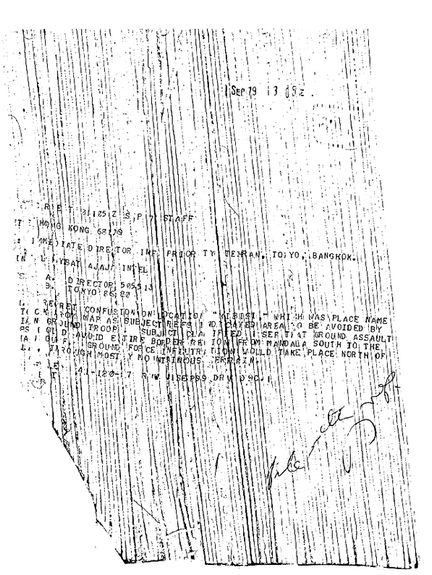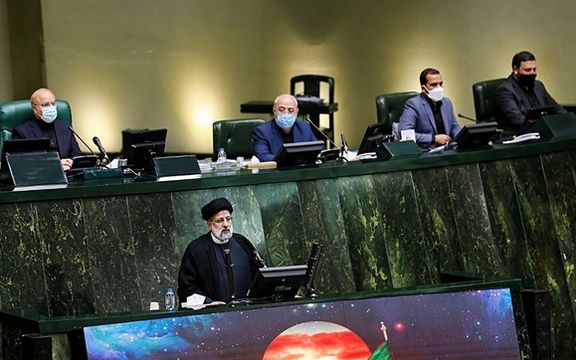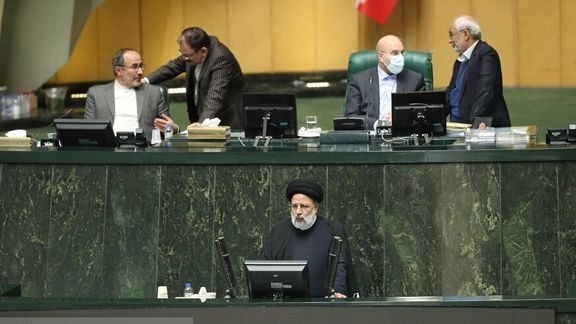Iran Injects $305 Million Into Currency Market After Rial's Fall

Iran’s government pumped $305 million into the currency market over two days, after the currency, rial, fell to a historic low of 450,000 against the US dollar.

Iran’s government pumped $305 million into the currency market over two days, after the currency, rial, fell to a historic low of 450,000 against the US dollar.
The Central Bank of Iran announced that the dollars were made available on Saturday and Sunday at a special currency scheme known as NIMA, which is set up for foreign currencies to be sold at a lower rate by exporters and for importers to buy what they need at the same low rate to finance their purchases from other countries.
The system was set up to make imports cheaper and control rising prices, after US sanctions in 2018 practically devalued Iran’s currency and led to very high inflation. The rial has lost value 12-fold in five years.
The injection of $305 million into the NIMA system indicates that there are not enough dollars from exports and the government had to satisfy demand.
However, the US dollar is set at 285,000 to the dollar in the special government scheme versus the free market where it is traded at about 450,000. The discrepancy between the two breeds corruption, as well-connected individuals and companies can buy cheap dollars through NIMA and instead of using it to finance imports, sell it on the currency market.
Numerous cases of such corruption have been revealed since 2018, when cheap dollars obtained from the government to import essential goods were used to import thousands of luxury cars, or simply nothing.
The government also regularly sells dollar through the free market to currency dealers to support the beleaguered rial. Usually, these interventions have a limited and temporary effect.

Thirty female political detainees in Iran’s notorious Evin prison in Tehran, have signed an open letter demanding an end to the "unjust sentences for prisoners" and their execution.
“We, the political and ideological prisoners in the women’s ward of Evin Prison, demand an end to the execution of protesters and an end to unjust sentences of prisoners in Iran,” they say in the petition.
The women inmates including French-Iranian academic Fariba Adelkhah, the daughter of a former president Faezeh Hashemi and political activist Sepideh Qolian say their group of 30 prisoners have been “sentenced to a total of 124 years in prison through unfair and non-transparent procedures.”
Despite coming from different religious and political backgrounds, “we have come together to say ‘no’ to execution. We defend people’s right to live in justice,” reads the petition.
The letter is published in a situation that according to the Norway-based Iran Human Rights Organization at least 109 protesters arrested since mid-September are at risk of imminent execution or death sentence.
This is apart from the four protestors that the Islamic Republic has already executed on charges of "corruption on earth and war against God," without access to a lawyer and a fair trial.
In more than four months, over 500 citizens have been killed by government agents, dozens of whom were children. In the meantime, about 20,000 protesters have also been arrested.

Islamic Republic’s education minister says parts of the documents obtained during the US embassy takeover in 1979 will be included in school textbooks as of next year.
Islamic Republic’s education minister says parts of the documents obtained during the US embassy takeover in 1979 will be included in school textbooks as of next year.
Yousef Nouri said Sunday that the move was done upon a call by Supreme Leader Ali Khamenei and the materials will be included in textbooks in all levels from the elementary school to the end of high school according to the level of understanding of the students.
He said that Khamenei urged the measure in a meeting with a group of students on November 2, 2022. Schoolbooks in Iran carry a heavy load of the regime ideology, with history re-written to fit its narrative, similar to what Communist regimes did in the 20th century.

According to Fars news agency, affiliated with the Revolutionary Guards, after the occupation of the US embassy in Tehran by revolutionary students, they “found documents there that showed American conspiracies against the Iranian nation," adding that the data extracted from the documents are compiled in 70 to 80 volumes of books.
According to an article published by The Washington Post in January 1982, hundreds of highly sensitive documents were captured and reconstructed after the embassy takeover. There were other documents that reportedly have not been deciphered or have been withheld from public consumption. “Although those published do not support the more egregious conspiracy theories of the militants, they have been used in an intensive campaign to arouse further distrust of the United States.”

The published documents, most of which have been authenticated by US sources, detail the US estimates of the regime of the late shah, Mohammad Reza Pahlavi, the forces which toppled him and the struggle to preserve American influence in Iran.
An article by the New York Times on July 10, 1986, said the documents were published under the title “Documents From the Espionage Den," the name the Islamic Republic uses for the US embassy. The books are sold openly in Tehran bookshops and included photocopies of the original telexes, mailgrams and typed letters from the embassy, classified reports, commentaries from the "students," and their complete translations into Persian.
Among the papers were shredded secret documents pieced back together by the attackers that detailed attempts of the Central Intelligence Agency to recruit high-level Iranian officials, ayatollahs, foreign journalists and diplomats as well as other CIA contacts either as paid or "unwitting” agents in the months after the revolution. “The documents shed light on the CIA's apparently unsuccessful attempt to recruit the former Iranian President Abolhassan Bani-Sadr, in the months just before the embassy takeover, when he was a member of the ruling Revolutionary Council and head of the Central Bank," said the article.
Some of the documents suggested that some of the members of the embassy's staff had been working with the CIA. Later, the CIA confirmed its role and that of MI6 in Operation Ajax -- the 1953 Iranian coup d'état that overthrew Prime Minister Mohammad Mosaddegh in favor of strengthening the monarchical rule of the Shah, Mohammad Reza Pahlavi.
The regime is expected to embed a heavy dose of its anti-American propaganda in the textbooks claiming it is substantiated by the embassy documents.
Earlier in the month, the Islamic Republic announced its intention to change the content of textbooks in foreign language schools after criticism by Khamenei. Head of Non-Governmental Schools and Centers Ahmad Mahmoudzadeh told ILNA Sunday that “We will have a call to produce content of language books for schools, which will be implemented in line with the order of the Supreme Leader.” "Language books that have nothing to do with our culture will be discarded," he added. Changing the content of textbooks based on the government's propaganda policies has been implemented in the last few years upon the order of Supreme Leader Ali Khamenei. However, this is the first time that these changes will be applied to the language teaching books of private institutes.
In August, the education minister said that 200 schoolbooks of the country’s education system will be revised as ordered by the Supreme Leader.

The Iranian parliament has approved the outlines of the budget bill for the next Iranian year – starting March 21 -- without considering its unrealistic assumptions.
President Ebrahim Raisi Sunday defended the bill at the parliament by a rhetorical statement, "The strategy of the enemy is to create despair, while the strategy of the government and the parliament should be to create hope in the hearts of the people." The deficit in the current budget that the government admits is about 4,760 trillion rials – more than ten billion dollars. But the real deficit will be perhaps twice as much, with rosy estimates of oil sales and staggering tax collection.
As the bill was being approved, the Iranian currency rial hit a new historic low, dropping to 455,000 against the US dollar. But that did not deter Raisi from claiming that Iran is witnessing “a very bright future,” citing data supposedly indicating that the country’s economy grew in the past year.

He claimed that "this year the country is witnessing an economic growth of four percent," adding that "a million jobs have been created in the country." When he presented the outlines of the budget, he had claimed that economic growth in this budget would be eight percent.
According to an International Monetary Fund report, economic growth will decrease from four percent in the previous Iranian year to three percent in the current year and two percent in the next year. That is still an estimate based on figures mainly supplied by the Iranian government.
Meanwhile, Gholamhossein Shafei, the head of Iran's Chamber of Commerce, said last year that the country's economic growth has been zero in the past 10 years.

The budget bill that was submitted to parliament more than a month late, places its hope on exporting 1.4 million barrels of oil per day, a lofty goal given that US sanctions are in place and Tehran is exporting less than a million barrels under current conditions. The budget also estimates that each barrel of oil can be sold at $85, while that is the highest price in global market, but Iran has to give steep discounts to ship illicit cargoes to its main buyer, China.
The total tax revenues planned in the draft budget will surpass $20 billion based on the current rate of exchange. In Iranian currency, however, this is a staggering 8.3 quadrillion rials – that is with 15 zeros.
Despite the huge tax bill for the people, the government budget will still have a 50-percent deficit, due to a chaotic downturn in the economy mainly triggered by US sanctions on its oil exports and international banking.
The 59-percent jump in planned tax collection means that taxpayers have to pay at least 10 percent more than the estimated 50-percent annual inflation rate.
The Raisi administration started with a rate of exchange for US dollars of 250,000 rials which has so far risen to over 450,000 rials.
Inflation in the country has soared to over 50%, the highest level in decades. Youth unemployment remains high with over 50% of Iranians being pushed below the poverty line, according to reports by Iran's Statistical Center.
The Iranian currency rial has lost its value by more than elevenfold in five years, making imports of food and other essential necessities equally expensive for consumers.

Thousands of people took to the streets of Brussels on Sunday to protest against the detention in Iran of Belgian aid worker Olivier Vandecasteele.
He was arrested last year and recently sentenced to a minimum 28 years in prison on charges including spying.
The Belgian government has said the charges are fake.
"His life is in danger, contribute to his freedom," "#Free Olivier Vandecasteele," read banners held by protesters who included Vandecasteele's family, friends and colleagues.
After Vandecasteele was sentenced last month, Belgium's justice minister said the Belgian had been imprisoned "for a fabricated series of crimes" and had been sentenced as retribution for a 20-year jail term Belgian courts imposed on an Iranian diplomat in 2021.
Belgium's constitutional court will next month hold a hearing on the legality of a Belgian prisoner exchange treaty with Iran. Belgian media has suggested this could lead to a prisoner swap between the two countries involving the Iranian diplomat, convicted of planning a bomb plot against an exiled opposition group, and Vandecasteele.
Opponents of the deal say that the deal would provide Iranian spies and potential terrorists de facto immunity in Belgium, turning the country into a base for dangerous activities.
Iran routinely detains Western citizens on bogus charges using them as bargaining chips to achieve its goals in disputes with the West.
With reporting by Reuters

Iran held an international congress called Women of Influence which apparently was a response to all-out pressures after ‘Women- Life- Freedom’ protests.
The First International Congress for Women of Influence was held in Tehran on Friday with the participation of female guests sent by Iran’s limited list of friendly governments.
The Islamic regime says wives of heads of state from Burkina Faso, Kyrgyzstan, Serbia, Guinea, Niger, Nigeria, Sri Lanka, Syria, Turkmenistan, and Armenia attended the event hosted by President Ebrahim Raisi’s wife Jamileh Alamolhoda.
Most notable was the presence of Zeynab Nasrallah, daughter of Lebanese Hezbollah leader Hassan Nasrallah.
Moderate news website Rouydad 24 wrote Sunday that the congress was a bag of big blunders and it was not even clear based on what parameters the list of influential women was prepared!
“The most basic thing in inviting influential women is that the guests must have done something special; not only because their husband is a famous person!” quipped Rouydad 24.
More importantly, in some cases, even the husbands of these women are not very important in the global equation.
In a speech, the emcee of the congress called Ebrahim Raisi's wife "the first lady of Iran" and said without her efforts, this congress would not have been possible at all.
It was expected that the first ladies of the closest friends of the Islamic Republic, namely Russia, China, and Syria, or at least several ministers or parliamentarians of these countries would attend the congress, Rouydad 24 pointed out, but apparently the foreign ministry was not successful even with Iran’s close allies.

“Except for Hamda bint Hassan Al Sulaiti, the Deputy Speaker of Qatari parliament and some African interior ministers, no ministers or parliamentarians or even high-ranking politicians of important countries attended the event,” underlined Rouydad 24.
The non-attendance of the first ladies of important neighboring and Muslim countries confirms the crisis in Iran’s relations with its neighbors.
Armenian prime minister’s wife attended the congress in a situation that Iran is engaged in a cold war with the Republic of Azerbaijan. So, the visit of the first lady of Armenia to Iran is more a message for Azerbaijan and its regional ally Turkey than paying respect to the Islamic Republic.
A least known Russian journalist also received the ‘influential woman’ award, while many top female journalists in Iran are in prison, stressed the report by Rouydad 24.
An Argentinian woman, who had studied at Iran’s religious Al-Mustafa University for foreigners, was introduced as another influential woman.
Al-Mustafa International University is in reality a seminary in the religious city of Qom to indoctrinate foreigners and gain influence in other countries.
The University pays for hundreds of foreign students from China to Africa and Latin America who come to study and then return to spread Iranian Shiite teachings in their countries.
According to the Secretary of the congress, a 20,000-euro prize has been awarded to every winner. If the claim of the congress organizers about the presence of 300 foreign guests in this meeting is true, the cost of plane tickets, their 5-day accommodation at a five-star hotel and their excursions in Iran came to a huge amount.
Amid the economic woes ordinary Iranians face, spending a huge amount of money on people with no influence is an important issue that needs more attention, criticized Rouydad 24.
In fact, in order to prove that Iran's expulsion from the United Nations Commission on the Status of Women and other foreign sanctions had no effect, the Raisi’s administration invited unknown guests in a strange move to show that Iran's relationship with the world is normal, reiterated the report.
Another point about the presence of these women in Iran was that the guests appearing in the ceremony wore outfits that had nothing to do with the mandatory hijab rules the Islamic Republic has killed over 500 people for since mid-September. In other words, women from other countries are free to wear whatever they like in Iran, but this right is an unattainable wish for Iranian women themselves.